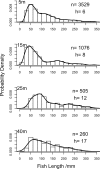Reef Fish Community Biomass and Trophic Structure Changes across Shallow to Upper-Mesophotic Reefs in the Mesoamerican Barrier Reef, Caribbean
- PMID: 27332811
- PMCID: PMC4917088
- DOI: 10.1371/journal.pone.0156641
Reef Fish Community Biomass and Trophic Structure Changes across Shallow to Upper-Mesophotic Reefs in the Mesoamerican Barrier Reef, Caribbean
Abstract
Mesophotic coral ecosystems (MCEs; reefs 30-150m depth) are of increased research interest because of their potential role as depth refuges from many shallow reef threats. Yet few studies have identified patterns in fish species composition and trophic group structure between MCEs and their shallow counterparts. Here we explore reef fish species and biomass distributions across shallow to upper-MCE Caribbean reef gradients (5-40m) around Utila, Honduras, using a diver-operated stereo-video system. Broadly, we found reef fish species richness, abundance and biomass declining with depth. At the trophic group level we identified declines in herbivores (both total and relative community biomass) with depth, mostly driven by declines in parrotfish (Scaridae). Piscivores increased as a proportion of the community with increased depth while, in contrast to previous studies, we found no change in relative planktivorous reef fish biomass across the depth gradient. In addition, we also found evidence of ontogenetic migrations in the blue tang (Acanthurus coeruleus), striped parrotfish (Scarus iserti), blue chromis (Chromis cyanea), creole wrasse (Clepticus parrae), bluehead wrasse (Thalassoma bifasciatum) and yellowtail snapper (Ocyurus chrysurus), with a higher proportion of larger individuals at mesophotic and near-mesophotic depths than on shallow reefs. Our results highlight the importance of using biomass measures when considering fish community changes across depth gradients, with biomass generating different results to simple abundance counts.
Conflict of interest statement
Figures







References
-
- Menza C, Kendall M, Hile S. The deeper we go the less we know. rev Biol Trop. 2008;56: 11–24.
-
- Puglise KA, Hinderstein LM, Marr J, Dowgiallo MJ, Martinez FA. Mesophotic Coral Ecosystems Research Strategy: International Workshop to Prioritize Research and Management Needs for Mesophotic Coral Ecosystems. coastalscience.noaa.gov. Jupiter, Florida, 12–15 July 2008. Silver Spring, MD: NOAA National Centers for Coastal Ocean Science, Center for Sponsored Coastal Ocean Research, and Office of Ocean Exploration and Research, NOAA Undersea Research Program; 2009 Nov p. 24. Report No.: NOAA Technical Memorandum NOS NCCOS 98 and OAR OER 2.
-
- Harris PT, Bridge TCL, Beaman RJ, Webster JM, Nichol SL, Brooke BP. Submerged banks in the Great Barrier Reef, Australia, greatly increase available coral reef habitat. ICES Journal of Marine Science. 2013;70: 284–293. 10.1093/icesjms/fss165 - DOI
-
- Bongaerts P, Ridgway T, Sampayo EM, Hoegh-Guldberg O. Assessing the “deep reef refugia” hypothesis: focus on Caribbean reefs. Coral Reefs. 2010;29: 309–327. 10.1007/s00338-009-0581-x - DOI
-
- Bridge TCL, Hughes TP, Guinotte JM, Bongaerts P. Call to protect all coral reefs. Nature Climate Change. 2013;3: 528–530. 10.1038/nclimate1879 - DOI
MeSH terms
LinkOut - more resources
Full Text Sources
Other Literature Sources

